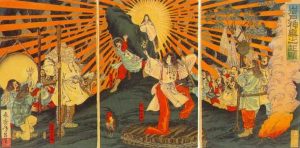The Birth of Amaterasu Omikami in Shinto
Not many religions today still have a female as their highest deity. As Japan has retained the animistic beliefs of Shinto from ancient times, the high status of the goddess was also retained. The stories of Amaterasu Omikami, the imperial high deity, mother of the imperial family, and goddess of the heavens, give much more information than the cosmogony and origins of Japan. Clearly the female had a much higher status in ancient Japan than in the current social order.
Female Priests and Warriors
Many religious roles in Shinto are filled by women. Females are allowed in the priestly roles in Shinto, and at Ise, the highest minister of the shrine from the 7th to 14th centuries has been a female member of the imperial household. It was also the daughter of the Emperor Suinin who searched for 20 years for the proper home for the goddess Amaterasu before coming upon the Ise area in 4 B.C.E.
In the Heian Period of the 12th century, women could inherit property and manage it by themselves. During the feudal years there were also female samurai, known as onna bugeisha, they were trained in warrior techniques and fought alongside male samurai. There were many of these female warriors from the upper class of samurai warriors. One leading figure is Empress Jingu who followed in her slain husband’s shoes and led the invasion of Korea in 200 C.E.
The Birth of Amaterasu
Amaterasu Omikami “the great deity who illuminates heaven,” also known as Hi no kami “deity of the sun,” is the first of three children of the male creator deity, Izanagi. Amaterasu is the greatest deity of all the children of Izanagi who rules the High Heaven. According to the Kojiki, the oldest version of her birth tells that while Izanagi was washing his left eye in a ritual purification following his attempt to revive the goddess Izanami, he gave birth to Amaterasu. Another version has Izanagi holding a white copper mirror in his left hand from which he creates Amaterasu. Izanagi then gave Amaterasu rule over the heavens and provided her with a special jewel necklace. An alternate version of her birth in the later record, the Nihongi, states that Izanagi and Izanami, having created all of the kami of the land, together decided to create a deity to rule over all and together they gave birth to Amaterasu.
Why Opposing Birth Myths?

The opposing stories of Amaterasu’s birth are similar to the opposing myths of the births of the Greek gods. From the earlier times in Greece, Greek goddesses were held in high regard. At first the earth goddess Gaia appeared, giving birth to the sky god Oranos, and together they created gods and goddesses which were the pantheon of the Titans. What follows reflects a change in culture and Greek history, as Zeus and the Olympians oust the Titans. Zeus gives birth to Athena from his head and misogyny is born as goddesses are no longer to be trusted (i.e. Pandora), nor are females needed in creation.
These opposing stories of gods and goddesses may express changes in matriarchal or matrilineal culture to patriarchal or patrilineal culture which is seen throughout world mythology and history. The same shift from female to male deities in mythology and accompanying changes in female status and roles is also seen clearly throughout the Near East as goddesses become gods even using the same names.
It is important to note that today Amaterasu still holds her femaleness and highest rank in the Shinto pantheon, although the culture is male-dominated. The stories are much older than the recording of the various versions and the recorded stories echo the important themes and viewpoints of the authors at the time.
More Evidence of Changing Status of Females
The Yayoi period shows evidence of women as chiefs of clans and as shamans, also important roles in society at the time. Chinese documents from the 3rd century C.E. show a female Queen Himiko who was a shaman or high priestess and queen of many tribes. She was selected by the Yayoi by popular vote to rule over them as she was able to reunite warring tribes. Himiko is recorded to have successfully ruled Yamataikoku, conducting transactions with the Chinese.
In medieval times, people considered Amaterasu a male deity showing a shifting need for a male high deity. The changing of Amaterasu from a female to a male deity reflects the changing status of females in the society where a high male authority is considered necessary in the mythology to reflect the male’s superiority in the culture.
In looking at the development of religion and mythology worldwide, the earth mother is the first and highest deity in hunter-gatherer cultures. Later in the beginning of agricultural culture the earth goddess is mated with the sky god who rains and fertilizes mother earth. This shared ruling by male and female deities is seen in the telling of the myth where Tsukiyomi no Mikoto is created as the Moon God and set in the heavens to be the consort of Amaterasu Omikami.
Finally, as a culture becomes increasingly technical and agricultural, a change to patriarchal customs is accompanied by a change in the supreme deities who may have once been female now become male. The abundance of female goddesses in Shinto, with Amaterasu at the lead, and their high status in the pantheon of deities is a reflection of the ancient cultural high status of the female.




